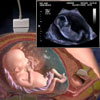- What is a pregnancy test?
- Pregnancy testing throughout history
- How does a pregnancy test work?
- Who uses pregnancy tests?
- When do I use a pregnancy test?
- How do I use a pregnancy test?
- After the pregnancy test
- What are the risks of pregnancy testing?
- What are the benefits of pregnancy testing?
What is a pregnancy test?

A pregnancy test is usually performed when a health professional or a woman suspects she is pregnant, or before using clinical services which may interfere with a pregnancy (e.g. prescription of hormonal contraceptives). Pregnancy tests are also used for other, less common reasons, such as diagnosing abnormally progressing pregnancies and gestational trophoblastic disease (molar pregnancy).
Blood pregnancy tests can be either qualitative (result is negative or positive) or quantitative (result is a specific hCG concentration). Blood pregnancy tests are more sensitive than urinary tests. They can distinguish between normally progressing and abnormal pregnancies (e.g. molar pregnancies, ectopic pregnancies), and enable a health professional to determine the length of time a woman has been pregnant. For such tests to be performed, blood must be collected by a health professional and analysed in a laboratory.
Urine samples provide an easy to interpret, positive or negative result, and can be carried out by the woman in the privacy of her own home. Urinary pregnancy tests kits are available over-the-counter at most chemists. They are also commonly used at health clinics to determine a patient’s pregnancy status.
Pregnancy testing throughout history
Pregnancy testing has a long history; the earliest records of urine pregnancy tests date back to 1350 BC. At this time, Egyptian women tested their pregnancy status by urinating on wheat and barley seeds for several days. According to this test, if the wheat seed germinated, a female child could be expected. Germination of a barley seed indicated a male child, while failure of either seed to germinate indicated no pregnancy. While this test sounds somewhat “hit and miss”, testing of the theory in the 1960s found that in 70% of cases the urine of a pregnant woman instigated seed growth, while the urine of men and non-pregnant women did not.
History provides a number of other examples of urinary pregnancy tests. In the middle ages, a woman’s urine would be examined, and women with pale yellow coloured urine (with a cloud on top) were diagnosed as being pregnant. In other cases, urine would be mixed with alcohol and the reactions observed to diagnose pregnancy status.
Until recently, the most practical means by which a sexually active woman could determine whether or not she was pregnant was by observing changes occurring in her body (e.g. morning sickness, absent menses).
In the 1890s, the study of the chemistry of the human body received widespread attention and scientists gained a better understanding of the chemicals internally secreted by human glands. Such secretions were named hormones. By the 1920s, hCG and progesterone, both important hormones in the foetal development process, had been identified. These discoveries paved the way for the development of new pregnancy tests based on the concentration of hormones.
In the first half of the nineteenth century, small animals such as mice or frogs were injected with the urine of women wishing to test their pregnancy status. If hCG was present in the urine, it would induce an ovulatory reaction in the injected female animal or sperm production in an injected male animal, and pregnancy would be diagnosed. The tests often failed to distinguish between luteinising hormone (a hormone secreted during a normal menstrual cycle) and hCG (a placentally derived, pregnancy-specific hormone), and thus many false positive pregnancies were diagnosed. Such tests were also reliant on the availability of laboratory animals and apparatus, and were cumbersome to perform because they required a lot of space, time and small animals.
By the 1960s immunoassays, which could predict pregnancy with a similar degree of accuracy to the previously used bioassays, had been developed. There were two main methods:
- Haemagglutination inhibition test: The haemagglutination inhibition test was developed in the early 1960s. It used purified hCG, a sample of the woman’s urine, and anti-hCG antibodies. These substances were mixed together in a test tube. If the woman was pregnant, red cells in the mixture would clump together. The haemaglutination inhibition test was much simpler to perform than the previously used bioassays, and could be used as either a qualitative or quantitative assessment of hCG concentration;
- Latex agglutination inhibition test: The latex agglutination inhibition test was also developed in the early 1960s. It used polystyrene latex particles coated with hCG. A mixture of centrifuged human urine and rabbit hCG anti-serum was prepared and added to the hCG-coated latex particle suspension. If the urine was free of hCG, the latex particles would agglutinate in response to the rabbit hCG anti-serum. If hCG was present in the urine, the hCG would neutralise the rabbit hCG anti-serum and agglutination of the latex particles would not occur.
Research continued in the 1970s. More important discoveries about hormones in general, and hCG specifically, lead to new pregnancy tests that were more accurate and less complex. Isolation of the alpha and beta subunits of hCG, and recognition that the beta subunit was a unique antigen (i.e. reacted with an antibody with which no other human hormones reacted), enabled scientists to develop more sensitive pregnancy tests based on reactions of hCG’s beta subunits.
These included:
- Radioimmunoassay: Radioimmunoassay used a radioactive plasma membrane receptor site containing anti-hCG antibodies to bind hCG, and in some cases to react specifically with beta-hCG. Radioimmunoassays increased the accuracy of pregnancy testing and could detect pregnancy as little as eight days after ovulation. However, they were expensive to conduct, relied on highly specialised equipment and medical personnel, and resulted in radioactive medical waste;
- Early pregnancy test: The early pregnancy test was the world’s first home pregnancy test. It was approved by the United States Food and Drug Authority in 1976 and was marketed for home use in 1977.
Further developments in producing hCG antibodies led to new and improved methods of pregnancy testing in the 1980s:
- Monoclonal antibody test: The monoclonal antibody test uses hCG antibodies, cloned from a single cell, that bind to hCG if present. The test is now commonly used as an enzyme-linked immonosorbent assay (ELISA) sandwich test involving three distinct antibodies and dye substrates that produce a colour reaction when the antibodies are activated (i.e. when a woman is pregnant). The monoclonal antibody test method is now the basis of most commercially marketed home pregnancy test kits.
How does a pregnancy test work?

Intact hCG molecules, which consist of two subunits known as the alpha and beta subunits, are similar to other human hormones. The beta subunit of hCG is unique, so testing for the presence of hCG using antibodies to the beta subunit enables the presence of hCG to be distinguished from the presence of other similar hormones. Modern pregnancy tests, whether they assess hCG levels in blood or urine, are based on this science.
Qualitative urine pregnancy test kits
A typical urinary pregnancy test kit provides a qualitative (i.e. positive/negative) result. It contains a test strip that is exposed to the urine of a potentially pregnant woman. The strip has a plasma membrane containing three types of antibodies and dyes in three distinct test zones: the reaction, test and control zones. The test strip should be exposed to urine at a specific point indicated in the manufacturer’s instructions (e.g. at one end, or by placing urine in a small well in the strip), following which urine will move through the zones.
Zone one, known as the reaction zone, contains monoclonal hCG alpha-chain specific antibodies. If hCG is present in the urine, these enzymes will bind to hCG molecules before passing through to the second zone, known as the test zone. In the absence of hCG in the urine, the enzymes will remain unbound, but will also be drawn along the test strip to the test zone.
The test zone contains polyclonal anti-hCG antibodies and a dye substrate that will react when the polyclonal antibodies are activated, indicating pregnancy. If hCG is present in the urine sample, it will have bound to hCG alpha-chain specific antibodies in the reaction zone of the test before reaching the test zone. The polyclonal anti-hCG antibodies (and then the colour reagent) are mobilised only in the presence of these bound molecules, so a coloured stripe or dot appears in the test zone only if hCG is present in the urine (i.e the woman is pregnant).
The third or control zone serves to validate that the test has been performed successfully. While the bound anti-hCG enzymes from the reaction zone interact with antibodies in the test zone, unbound enzymes continue to be drawn along the test strip to the control zone. Here they react with a third antibody and then mobilise a second dye substrate. A coloured line or dot therefore appears in the control zone if the test worked properly.
Quantitative blood pregnancy tests
Similar to urine pregnancy test kits, blood pregnancy tests use a combination of hCG antibodies that bind to hCG molecules and cause a colour reaction to occur. Unlike qualitative tests, quantitative tests are designed so that a reaction occurs in individual hCG molecules, which can then be counted to determine a specific concentration of hCG in the sample. Professional training is required to to carry out and interpret the results of this test, which is why blood pregnancy tests are carried out in laboratories.
The specific antibodies used in a blood test vary depending on the brand of test and its specific diagnostic purpose (e.g. whether it is intended to diagnose pregnancy or gestational trophoblastic disease).
Blood tests may be designed to react with intact hCG molecules, free beta subunits of hCG, or degraded forms of hCG. hCG occurs in different forms depending on the condition that is stimulating hCG production. Health professionals can test for a specific type of hCG to distinguish between conditions. For example, gestational trophoblastic disease produces hCG in free beta subunits whereas normal pregnancies do not, so a test that specifically reacts with free beta subunits of hCG is used if this condition is suspected.
Who uses pregnancy tests?
Pregnancy tests are used in a range of clinical settings as well as in the home. The type of test used varies between settings.
Blood pregnancy tests tend to be used in more specialised settings to diagnose specific conditions. For example, a blood pregnancy test may be used to diagnose a suspected ectopic pregnancy, or to rule out ongoing pregnancy following medical abortion.
Urine pregnancy tests are the most commonly used pregnancy tests. All home pregnancy tests, and most tests used in routine clinical practice, assess urine rather than blood samples. The popularity of home pregnancy test kits has increased rapidly since their introduction in 1976, with more than 19 million kits being sold in the United States in 1999. In the US, some 33% of women who attend clinics for pregnancy-related care have used a home pregnancy test to check their pregnancy status before visiting a health professional. A study of adolescents attending clinics in the US revealed that 34% of sexually active attendees had used a home pregnancy test at some point in the past.
When do I use a pregnancy test?
There are many situations in which a pregnancy test may be used. The timing of the test and the appropriate type to use depend on the suspected condition.
A urine test kit is usually used to assess pregnancy status. The test is ideally performed one week after a missed period, as embryo implantation and hCG production have not commenced on the first day of missed menses in some 10% of women. Testing on the day of missed menses may also diagnose a number of pregnancies that spontaneously abort (i.e. miscarry) in the early stages, which if not tested would appear to be a late menstrual cycle. Identifying these pregnancies by testing on the first day of missed menses can create unnecessary anxiety for the pregnant woman and unnecessarily consume health system resources.
|
Menstruation occurs in cycles. The ovaries prepare an egg (oocyte) for release and the womb (uterus) prepares a lining to nourish the egg if it is fertilised. When the egg is not fertilised, the lining of the womb is shed and a woman gets her period (menstrual bleeding). Menstruation typically occurs in 28 day cycles so most women get their period every 28 days. However, some women have longer cycles and may only get their period every 40 days, while other have shorter menstrual cycles and may get their periods as often as every 21 days. The menstruation calculator determines when your next period is due based on a 28 day menstrual cycle. All you need to do is enter the date when your last menstrual bleeding began, and the calculator will tell you when to expect your next period. |
|
| 1. Select your menstrual cycle length: days | |
|
2. Select your last Menstrual Date:
|
Next Menstrual Date Due:
|
|
The information presented here is for general purposes only and should not be used to make diagnosis or treatment decisions. For specific information about your health you should see a health professional. Reference
|
|
A suspected ectopic pregnancy can be diagnosed or ruled out by taking serial, quantitative measures of blood hCG. Such measures are often taken in conjunction with transvaginal ultrasound.
If a pregnancy is progressing normally, hCG levels will rise exponentially in the first 7–10 weeks of pregnancy. Smaller hCG increases are indicative of ectopic pregnancy.
Diagnosis or post-evacuation of a molar pregnancy
Women should have a weekly quantitative pregnancy test to assess the success of treatment following the diagnosis or evacuation of a molar pregnancy. Persistently elevated hCG levels indicate the need for further treatment (e.g. chemotherapy).
A quantitative pregnancy test should be performed following a medical abortion to confirm successful termination has occurred. In instances where pregnancy is ongoing (i.e. hCG is found in the tested sample), surgical abortion should be performed.
Before clinical services for which pregnancy is contraindicated
A qualitative urine pregnancy test should be used to rule out the possibility of pregnancy before hormonal or other contraceptives (e.g. intrauterine devices) are prescribed. Other clinical services before which a woman may be required to check her pregnancy status include pelvic, gynaecological and abdominal surgery, and diagnostic imaging (e.g. x-ray).
How do I use a pregnancy test?
While many women assess their pregnancy status at home for the sake of confidentiality and convenience, taking a pregnancy test at a health clinic enables the woman to access a range of related services and receive individual advice from a health professional before, during and after the test.
At all times when performing a pregnancy test, health professionals have a legal obligation to maintain confidentiality. The only cases in which a health professional is legally able to discuss a client’s pregnancy status without her consent is in cases where sexual abuse of a minor is suspected. In such cases, health professionals are required to disclose information to appropriate welfare and/or legal institutions.
Before performing a pregnancy test, the doctor or nurse will ask the woman about their medical history, including details of their past sexual health history, date of last menses and intercourse, usual menstrual cycle length, and current contraceptive methods. The doctor is likely to ask whether or not the pregnancy is planned and wanted, determine the consequences of a positive or negative result, and provide appropriate counselling on that basis.
When the test is a urinary test, collect mid-stream, first morning urine in a clean, dry container. First morning urine is used because it contains the highest concentration of hCG. However, in instances where this proves impractical, urine collected at any time of day will suffice.
When the test is a urinary test kit (either for home or clinic use), check the expiry date, remove the kit from its packaging and place it on a level surface. Apply urine to the reactive strip on the test kit according to the manufacturer’s instructions. Use a timer and read the test result after the length of time recommended by the manufacturer. If the test is performed at a clinic, the consulting doctor will perform these steps before informing the patient of the result and providing appropriate post-test counselling.
If the result is negative but pregnancy is still suspected, a repeat test should be performed using early morning urine.
After the pregnancy test

Women with a positive pregnancy test should consider accessing health services:
- Antenatal care: All pregnant women who wish to proceed with their pregnancy should access antenatal care early in their pregnancy to ensure their own health and the health of the developing foetus.
- Pregnancy termination and adoption services: Pregnant women who do not wish to proceed with their pregnancy should obtain a referral to a pregnancy termination service provider from their doctor. The doctor will also be able to provide accurate and evidence-based advice about the availability of pregnancy termination and adoption services, and the risks involved in terminating a pregnancy.
- Screening for Chlamydia trachomatis infection: A recent study recommended screening all pregnant women under 25 years of age for C. trachomatis infection because of the high prevalence of infection in this age group (13.7% in under-20 year olds), as well as the high risk of pregnancy and postpartum complications associated with the infection.
- Nutritional and behavioural counselling: Pregnant women who wish to proceed with their pregnancy should discuss their nutritional requirements with a health professional. They should also be informed about behaviours such as consuming alcohol, nicotine and other potentially harmful substances that may affect their health and the health of their foetus.
- Psychosocial support: For many women, a positive pregnancy test is an exciting time; however, for others a positive result may be the source of anxiety and distress. Psychological and social support can help women cope with and make decisions about their unwanted pregnancy and avoid psychological disorders associated with pregnancy (e.g. depression). Young women, those who do not want to be pregnant, and those who will be delivering for the first time are more likely to experience depression than other pregnant women.
For women with a negative pregnancy test the following health services should be considered:
- Contraceptives: A wide range of safe, inexpensive, long term contraceptive methods exist, as well as emergency contraceptives. Women who have had a negative pregnancy test and do not wish to become pregnant should discuss their contraceptive options with a health professional so that an appropriate method can be determined.
- Infertility treatment: For women who want to be pregnant but have received a negative result, a doctor will be able to provide advice and referral to an infertility treatment centre (usually only if the woman has been trying without success to fall pregnant for at least 12 months).
How accurate are pregnancy tests?
There are a number of types of pregnancy tests commonly used today. Regardless of type, the accuracy of pregnancy tests depends on the timing of the test – when the test is performed in relation to when conception occurred.
The obvious time at which a woman might seek a pregnancy test is on the first day of a missed period. However, there is no practical way of determining a woman’s pregnancy status before embryo implantation (when hCG production begins), an event which occurs 6–12 days after ovulation. In practical terms, this means that the embryo will not have implanted and hCG production will not have begun on the first day of the missed menstrual cycle for 10% of women. Therefore, hCG-based pregnancy tests can only detect 90% of pregnancies when taken on the first day of a missing period.
The accuracy of pregnancy tests also vary depending on the type of test, condition being diagnosed and the experience of the person administering the test.
A quantitative blood test is the most sensitive hCG pregnancy test. A clinician can determine the exact levels of hCG in a woman’s blood, based on the number of bound hCG molecules that appear on the test strip.
Gestational age can be estimated using the known concentration of hCG in the blood, and the estimated hCG concentration at various stages of the first trimester of pregnancy. Serial measures of the quantitative test can be used to diagnose abnormal pregnancies or pregnancy-related tumours, as hCG concentrations during these pregnancies do not follow the typical pattern of exponential hCG increase in the first weeks of pregnancy.
Quantitative blood pregnancy tests are the most accurate pregnancy tests and considered to be 100% sensitive in the presence of hCG. However, sometimes a false positive result may be obtained because of the presence of non-pregnancy related sources of hCG.
A qualitative blood test for the presence or absence of hCG in a woman’s blood indicates the presence or absence of a pregnancy, but cannot indicate gestational age. The quantitative blood test is highly accurate (99.5–100% depending on the manufacturer).
Urine tests determine the presence or absence of hCG in a woman’s urine, and indicates pregnancy status but not gestational age. Many manufacturers of home pregnancy tests report a greater than 99% accuracy for their kits from the first day of a missing period; however, scientific studies of the use of these tests in the home have revealed a much lower accuracy. A study of 16 home pregnancy tests reported that 25% of pregnant women using these tests in the home incorrectly obtained a negative result.
What are the risks of pregnancy testing?
There are no risks to a woman’s health associated with pregnancy testing.
Women using home tests should be aware of the possibility of false negative results. They should see a health practitioner following a negative pregnancy test result if pregnancy symptoms persist (e.g. morning sickness).
What are the benefits of pregnancy testing?
Pregnancy tests, particularly those that can be conducted by women in the privacy of their homes, have led to the earlier diagnosis of pregnancy. Early diagnosis enables early preventative interventions to ensure the health of the woman and her developing foetus (e.g. antenatal care, avoidance of alcohol and nicotine). Early diagnosis is also beneficial for women who do not wish to proceed with their pregnancy, as it enables the pregnancy to be terminated in the early stages (i.e. first trimester) and therefore reduces the complexity and increases the safety of the termination procedure.
More information
 |
For more information about pregnancy, including preconception advice, stages of pregnancy, investigations, complications, living with pregnancy and birth, see Pregnancy. |
 |
For more information about pregnancy planning, including importance of nutrition before pregnancy, being under-weight, being overweight, tobacco exposure and alcohol consumption, see Pregnancy Planning (Preconception Advice). |
 |
For more information about different pregnancy investigations, including pregnancy tests, obstetric ultrasound, amniocentesis and chorionic villus sampling as well as useful tools and animations, see Pregnancy Investigations. |
References
- Wilcox AJ, Baird DD, Dunson D, McChesney R, Weinberg CR. Natural limits of pregnancy testing in relation to the expected menstrual period. JAMA. 2001; 286(14): 1759-61.
- Kraszewski S.Procedure for pregnancy testing. Nurs Stand. 2007; 22(12): 45-8.
- Bastian LA, Nanda K, Hasselblad V, Simel DL. Diagnostic efficiency of home pregnancy test kits. A meta-analysis. Arch Fam Med. 1998; 7(5): 465-9.
- Office of NIH History. A thin blue line: The history of the pregnancy test kit [online]. National Institutes of Health. 2003 [cited 5 January 2009]. Available from URL: http://history.nih.gov/ exhibits/ thinblueline/ timeline.html
- Hobson BM. Routine pregnancy diagnosis and quantitative estimation of chorionic gonadotropin using female Xenopus laevis. J Obstet Gynaecol Br Emp. 1952; 59(3): 352-62.
- Wide L, Gemzell CA. An immunological pregnancy test. Acta Endocrinol (Copenh). 1960; 35(2): 261-7.
- Garden NR, Miller H, Durant JA. Serological pregnancy test using latex particles: An assessment of its reliability and convenience. Br Med J. 1963; 2(5355): 480-3.
- Batzer FR. Guidelines for choosing a pregnancy test. Contemp Obstet Gynecol. 1985; 26: 37-51.
- Bluestein D. Monoclonal antibody pregnancy tests. Am Fam Physician. 1988; 38(1): 197-204.
- Conception Technologies. Assure hCG Urine Pregnancy Test [online]. 2 May 2001 [cited 5 January 2009]. Available from URL: http://www.conceptiontechnologies.com/ images/ ReferencesPDFs/ assurehcg_cassette.pdf
- Quidel Corporation. Procedure manual: QuickVue one step hCG urine test [online]. 2 May 2008 [cited 5 January 2009]. Available from URL: http://www.quidel.com/ libraries/ nccls/ RD/ QVOneStep_hCGUrine.pdf
- Inverness Medical. Pregnancy test, urine, signify [online]. University of Texas Medical Branch. 2008 [cited 5 January 2009]. Available from URL: http://www.utmb.edu/ poc/ SOP/ 2009/ SOPhcg Inv Med_Signify2009.pdf
- Feldkamp CS, Pfeffer WH. The measurement of human chorionic gonadotropin for pregnancy testing. Henry Ford Hosp Med J. 1982; 30(4): 207-13.
- Olsen TG, Barnes AA, King JA. Elevated hCG outside of pregnancy – diagnostic considerations and laboratory evaluation. Obstet Gynecol Surv. 2007; 62(10): 669-74.
- Grossman D, Berdichevsky K, Larrea F, Beltran J. Accuracy of a semi-quantitative urine pregnancy test compared to serum beta-hCG measurement: A possible screening tool for ongoing pregnancy after medication abortion. Contraception. 2007; 76(2): 101-4.
- Utuski S, Kawano N, Oka H, Tanaka T, Suwa T, Fujii K. Cerebral germinoma with syncytiotrophoblastic giant cells: Feasibility of predicting prognosis using the serum hCG level. Acta Neurochir (Wien). 1999; 141(9): 975-8.
- Lurain JR. Chapter 14: Treatment of metastatic gestational trophoblastic tumors. In: Hancock BW, Newlands ES, Berkowitz RS, Cole LA (eds). Gestational Trophoblastic Diseases (2nd edition). Sheffield: International Society for the Study of Trophoblastic Diseases; 2003, 305-18 [online]. International Society for the Study of Trophoblastic Diseases (ISSTD). 21 May 2003 [cited 5 January 2009]. Available from URL: http://www.isstd.org/ gtd/ 14 word for print.pdf
- Tay JI, Moore J, Walker JJ. Ectopic pregnancy. BMJ. 2000; 320(7239); 916-9.
- Borrelli PT, Butler SA, Docherty SM, Staite EM, Borelli AL, Iles RK. Human chorionic gonadotropin isoforms in the diagnosis of ectopic pregnancy. Clin Chem. 2003; 49(12): 2045-9.
- Shew ML, Hellerstedt WL, Sieving RE, Smith AE, Fee RM. Prevalence of home pregnancy testing among adolescents. Am J Public Health. 2000; 90(6): 974-6.
- Cole LA, Sutton JM. Selecting an appropriate hCG test for managing gestational trophoblastic disease and cancer. J Reprod Med. 2004; 49(7): 545-53.
- Drebitko CN, Sadler LS, Leventhal JM, Daley AM, Reynolds H. Adolescent girls with negative pregnancy tests. J Pediatr Adolesc Gynecol. 2005; 18(4): 261-7.
- Trinh LT, Rubin G. Late entry to antenatal care in New South Wales, Australia. Reprod Health. 2006; 3: 8.
- Cheney K, Wray L. Chlamydia and associated factors in an under 20s antenatal population. Aust NZ J Obstet Gynaecol. 2008; 48(1): 40-3.
- Kitamura T, Sugawara M, Sugawara K, Toda MA, Shima S. Psychosocial study of depression in early pregnancy. Br J Psychiatry. 1996; 168(6): 732-8.
- National Collaborating Centre for Women’s and Children’s Health. Fertility: Assessment and treatment for people with fertility problems: Clinical guideline [online]. London: Royal College of Obstetricians and Gynaecologists. 23 February 2004 [cited 5 January 2009]. Available from URL: http://www.rcog.org.uk/ files/ rcog-corp/ uploaded-files/ NEBFertilityFull.pdf
- Mishalani SH, Seliktar J, Braunstein GD. Four rapid serum-urine combination assays of choriogonadotropin (hCG) compared and assessed for their utility in quantitative determinations of hCG. Clin Chem. 1994; 40(10): 1944-9.
- Guyton AC, Hall JE. Textbook of Medical Physiology (11th edition). Philadelphia: Elsevier Saunders; 2006, 1032.
All content and media on the HealthEngine Blog is created and published online for informational purposes only. It is not intended to be a substitute for professional medical advice and should not be relied on as health or personal advice. Always seek the guidance of your doctor or other qualified health professional with any questions you may have regarding your health or a medical condition. Never disregard the advice of a medical professional, or delay in seeking it because of something you have read on this Website. If you think you may have a medical emergency, call your doctor, go to the nearest hospital emergency department, or call the emergency services immediately.







